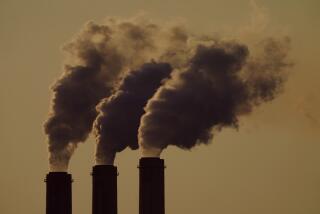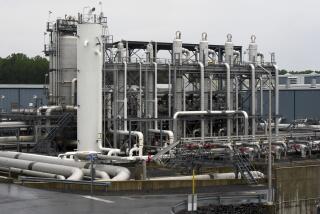Obama considers sweeping climate plan
WASHINGTON — The Obama administration is considering a sweeping initiative to address climate change, including the first-ever limits on carbon dioxide from power plants, the country’s biggest source of greenhouse gas emissions, according to people familiar with the discussions.
The White House has yet to settle on specific measures, but “we’re hearing that existing power plants are definitely in the mix,” said a person with knowledge of the deliberations, who, like others, asked not to be identified to talk about White House discussions. An announcement could come by mid-July.
Power plants account for about a third of the country’s greenhouse gas emissions, with most of the carbon dioxide coming from coal-fired plants and, to a lesser extent, natural gas generation. Issuing rules to curtail their pollution would almost certainly touch off a battle in the courts and Congress.
“There are only a few substantive, meaningful actions the administration can take short of dealing with existing power plants,” said S. William Becker, executive director of the National Assn. of Clean Air Agencies, a group of local and state air pollution regulators. “So I’d be extremely surprised if existing power plants weren’t one of the top priorities the administration is pursuing.”
The White House declined to comment on the deliberations, instead citing President Obama’s past comments on climate change. The Edison Electric Institute, the power industry’s trade group, also declined to comment.
Still, Heather Zichal, White House deputy assistant for energy and climate change, said at an environmental conference in Washington last week that “in the coming weeks and months, you can expect to hear more from the president on this issue.”
At the start of his second term, Obama identified climate change as one of his top priorities, along with immigration and the federal deficit. But then the administration appeared to pull back. Long-awaited final rules to limit greenhouse gases from new power plants have been delayed, and the White House has been silent on any plan to control emissions from existing power plants.
But in recent weeks, the administration has begun to move on its climate agenda. Most notably, Obama and Chinese President Xi Jinping announced recently that the countries would phase down and eventually halt the production and use of hydrofluorocarbons, potent heat-trapping gases used as chemical refrigerants in air conditioners and other appliances. The United States and China now plan to work to get other countries, in particular India, to join the effort.
Three years ago, Obama pledged that the U.S. would lower its greenhouse gas emissions to 17% less than 2005 levels by 2020. The administration’s fuel economy rules for motor vehicles have helped rein in emissions. Carbon dioxide output has also fallen because the economy slowed and cleaner-burning natural gas plants are replacing coal-fired plants. Yet the U.S. cannot meet that target without enacting new regulations or laws, according to analysts and regulators.
Republican lawmakers have largely rejected the idea that human activity has caused climate change, precluding the chance of passing new legislation. As a result, the administration has to act on its own.
Rep. Edward Whitfield (R-Ky.), chairman of the House Energy and Commerce subcommittee on energy and power, could not be reached for comment.
But to make a deep dent in carbon dioxide emissions, the administration would have to tackle the politically touchy subject of power plants. Any rule issued by the Environmental Protection Agency would no doubt trigger a lawsuit by opponents. Congress could also try to attach riders to spending bills that would stop funding for greenhouse gas standards, said Daniel J. Weiss, director of climate strategy at the Center for American Progress Action Fund.
The EPA could make new power plant rules more palatable if it avoided a one-size-fits-all approach, Becker said. The states would have to enforce the standards. The EPA could work with states to set up target reductions of greenhouse gases for each state. A state with many coal plants, such as Ohio, might not be able to meet its target as fast as a state such as Washington, which relies greatly on hydroelectricity.
Environmentalists and regulators said a new climate initiative might contain energy efficiency programs and efforts to eliminate leaks of methane, another potent greenhouse gas, from oil and gas drilling operations and pipelines.
“This is an important issue to the president. It’s a question of his legacy,” said Rep. Henry A. Waxman (D-Beverly Hills), ranking member on the House Energy and Commerce Committee. “Five years from now, people will be talking about what the Obama administration did on climate change, not entitlements or the deficit or whatever they are talking about now. Because climate change is here and real, and we have to address it.”
More to Read
Start your day right
Sign up for Essential California for news, features and recommendations from the L.A. Times and beyond in your inbox six days a week.
You may occasionally receive promotional content from the Los Angeles Times.







